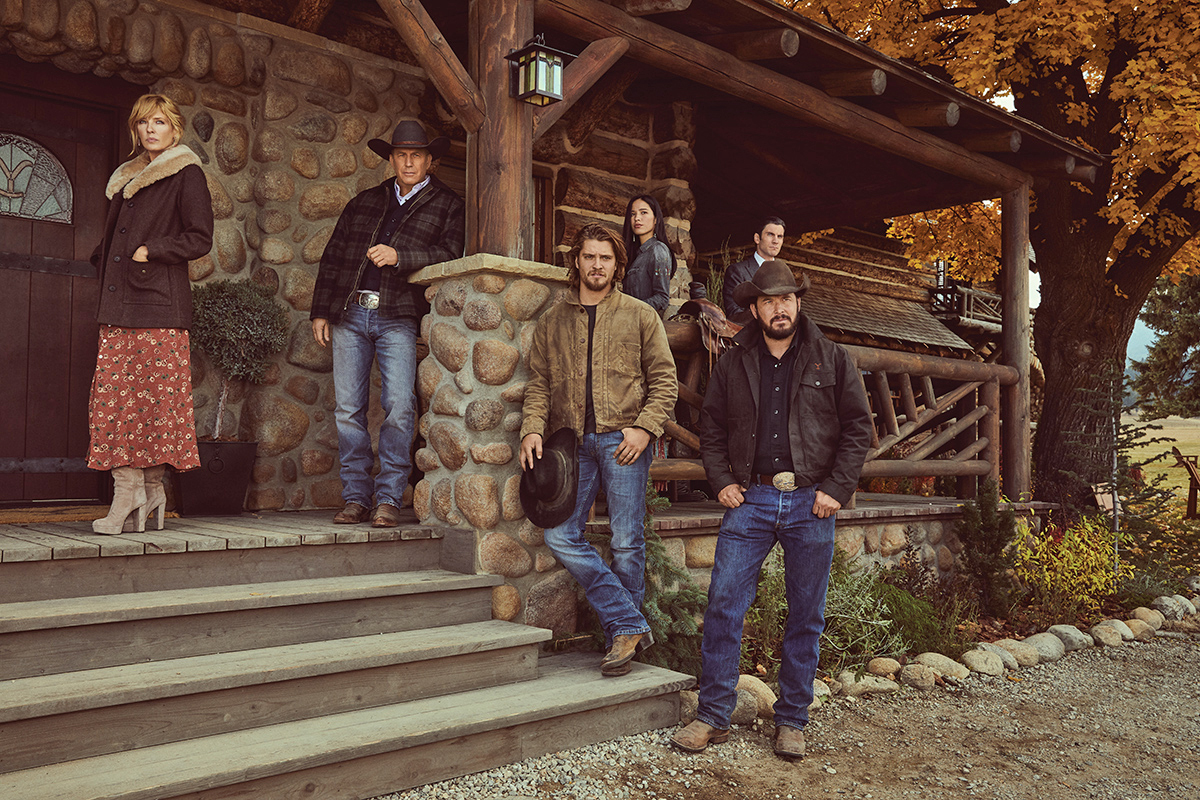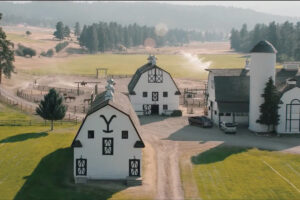This special edition of PERC Reports uses the hit television show “Yellowstone’s” portrayals of the Rocky Mountain West to examine real-world western issues. Explore the full issue here.
People are watching “Yellowstone.” Lots of people. The Season 4 premiere of the blockbuster television series drew nearly 15 million viewers in one night. It is now the most-watched television series in the country. It’s even been cited as a contributing factor for Montana’s modern land rush.
For the unfamiliar, “Yellowstone” gives viewers a look at the contemporary American West and features a cast of rising stars as well as veteran actor Kevin Costner. But “Yellowstone” at its core is about the landscape. It shapes the issues and plot lines covered in the series. And that’s where PERC’s interest comes in.
Set in Paradise Valley near Yellowstone National Park and Bozeman, Montana—PERC’s home—the main character of the show is the fictional Yellowstone Dutton Ranch, the largest contiguous ranch in the United States. The current patriarch of the multi-generational ranching dynasty is John Dutton, played by Costner, who has made a life starring in nearly four decades’ worth of classic westerns, including “Silverado,” “Dances with Wolves,” and “Open Range.” Defending the ranch alongside him are his children, cutthroat banker Beth, former Navy SEAL Kayce, and lawyer Jamie. Rip Wheeler is the loyal ranch manager.
The show is a case study of Old West meeting New West and the conflicts that ensue. Those out to strip the Duttons of their land and their ranching way of life include the California developer Dan Jenkins and the casino-minded Thomas Rainwater, tribal leader of a nearby Indian reservation. In the first confrontation between developer and rancher, Jenkins tells Dutton, “Progress doesn’t need your permission.” To which Dutton, in a gravelly voice, replies, “In this valley it does.”
What makes the show so compelling is that most westerns are a cliche of the West developed by people not of the West. Not “Yellowstone.” Yes, there are explosions, extreme violence, exaggerations, and moments of suspended disbelief that can elicit eye rolls from locals. But throughout it all are kernels of reality and truth. The underlying issues the show deals with are real—and often unappreciated by people not from the region. You can trace most of the plot lines to events and happenings in Montana. As Luke Grimes, the actor who plays Kayce Dutton, says, “‘Yellowstone’ is an elevated and heightened version of things that actually exist.”
“Yellowstone’s” creator, Taylor Sheridan, had zeroed in on so many issues that PERC researchers have covered through the years—water rights conflicts, stream access laws, weaponization of the Endangered Species Act, wildlife compensation funds, western fence law, brucellosis transmission, and, of course, the nature of property rights.
There is a word for it: authentic. The show comes from someplace real. Ranchers I speak with in the actual Paradise Valley appreciate the reality under the surface. The series features issues they grapple with every day. Here in Montana, we often tell stories or hear of some incident or conflict and say, “That’ll be a scene in ‘Yellowstone.’”
A couple of years ago, PERC researchers were visiting a cattle ranch near Montana’s Crazy Mountains. Somehow “Yellowstone” came up in the introductory conversation with the husband and wife who own the ranch, which has been in the family for more than 100 years. They indicated the show was a little outlandish for their tastes. But then, they proceeded to tell a story about three hunters going into the mountains nearby and only two coming out. An extensive search for the missing hunter was called off after the snows of winter began to fly. The incident became the subject of many suspicious theories, most focusing on the surviving hunters. Strange men showed up at the ranch months later seeking permission to hike through the family’s property to access the mountains. Ultimately, the body of the hunter was found on a hillside above the ranch, many, many miles and on the other side of the range from where the group was hunting. We all looked at each other astonished, saying that sure sounds like something out of “Yellowstone.”
The idea for a workshop based on “Yellowstone” was hatched several years ago over whiskey and wine at a Bozeman dinner with a handful of PERC board members and senior fellows. Season 2 was airing, and the conversation centered on how uncanny it was that “Yellowstone’s” creator, Taylor Sheridan, had zeroed in on so many issues that PERC researchers have covered through the years—water rights conflicts, stream access laws, weaponization of the Endangered Species Act, wildlife compensation funds, western fence law, brucellosis transmission, and, of course, the nature of property rights. Could these insightful scenes from the show be a tool for a deeper dive into western natural resource issues? An opportunity for “Yellowstone” fans and those curious about the West to learn more about the real-life issues behind the gloss?
The answer is in your hands now (read the full issue here). Last summer, a small group of PERC scholars and practitioners spent two days huddled up in discussion sessions focusing on scenes from the show, led by our resident third-generation cattle rancher and senior fellow P.J. Hill, whose grandfather started ranching in southeastern Montana in 1892. Thanks to our friend Cody Hyde, who does horse work for “Yellowstone” (and makes a cameo in Season 3), we were able to have Taylor Sheridan join us for a session about the issues of the Rocky Mountain West as he sees them. And then there was the big surprise: Luke Grimes, aka Kayce Dutton, showed up along with Cody in person to participate in the first day of the workshop.
We weren’t sure if the idea would be fortune or flop. In the months leading up to the workshop, several PERC scholars jumped into the project with gusto, binge watching the show to stake their claim to key scenes for their papers. Others remained politely skeptical. But if there was any doubt, the hour with Taylor Sheridan sealed the deal. Sheridan quickly proved that he was not a Hollywood captive—he grew up on a ranch in Texas and joined us virtually from his home in Wyoming. A brilliant writer and storyteller, he acutely understands the region, the land, and the culture. That’s because, as he says, “a story chooses you”—a good one is the world that you know. Taylor Sheridan knows Yellowstone Country.
“Yellowstone” provides a treasure chest of fodder.
Embarking on a detailed discussion of cattle economics, Sheridan articulated one of the big challenges for the ranching way of life: how to make more money on less cow. Inheritance taxes are a constant threat, too. He shared personal experiences that infused the show’s writing, told comical stories about visits to Yellowstone National Park, and explained that as a storyteller, he tries not to judge but to present both sides. He also informed us that over Memorial Day weekend, 11 million viewers tuned in to watch the replays of the first three seasons of “Yellowstone,” with most of them on the East and West Coasts. To us, that sounded like opportunity—a common mission with Sheridan to, in his words, “educate and enlighten.”
And “Yellowstone” provides a treasure chest of fodder. In one scene that resonates here in Montana, a grizzly bear is in a field off a county road digging for roots while a busload of overseas visitors has wandered too close to the bruin, which is on Dutton land, to get a better look. In fact, there is an actual remote basin outside of Bozeman where, for a couple of months a year, grizzlies come out of the national forest onto private ranchland to dig for caraway root. Like a good trout fishing hole, a place once kept quiet among locals is now being quickly discovered by wildlife watching tours.
In “Yellowstone,” John Dutton sees the grizzly situation unfolding and pulls his truck over to “educate” the trespassers. He explains that he owns all of the land from horizon to horizon, and that they are too close to the bear that the tour translator said “seems friendly.” One of the tourists confronts him, saying that no one should own that much land, that the land should be shared with all people. Firing his rifle in the air to scatter the tourists, Dutton replies: “This is America. We don’t share land here.” It was typical “Yellowstone”—capturing the sanctity of property rights felt by landowners, while also showing the disconnect of people to our natural world—a New West phenomena that we often bear witness to.
A few months after our workshop, I had the opportunity to spend more time with our new friend Luke Grimes in the real Paradise Valley. From a vantage point overlooking this historic and breath-taking valley, we discussed expeditions and settlement, cattle drives and geography, wildlife and today’s ranching culture. I had the opportunity to point out a distant south-facing hillside where PERC is helping a multi-generational ranch family balance their cattle operations with elk migrations across their land. We talked about wild horse adoptions—another issue PERC is working on—and what it was like to ride adopted wild horses in the show. And we discussed a nearby fence line where just weeks earlier I stood talking to my neighboring rancher on horseback, who needed help with some cows that had gotten loose on our side of the fence—an example of neighborly cooperation rather than conflict. It brought it all together. The issues of the Rocky Mountain West. “Yellowstone” and PERC. Art imitating life, but at the same time, life imitating art.





